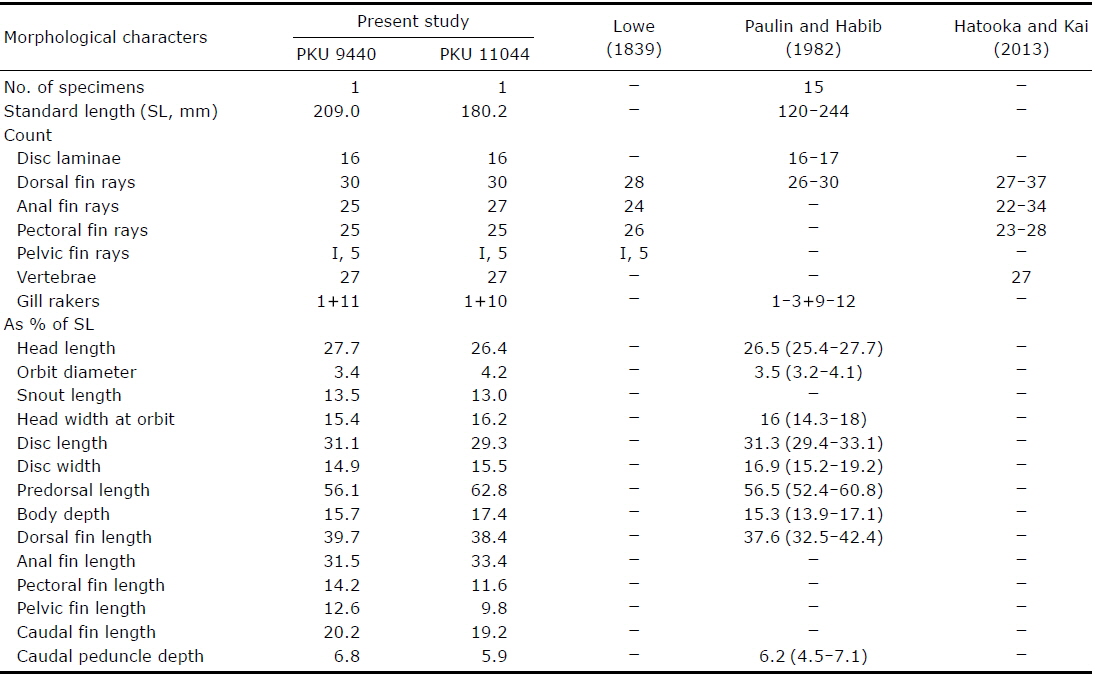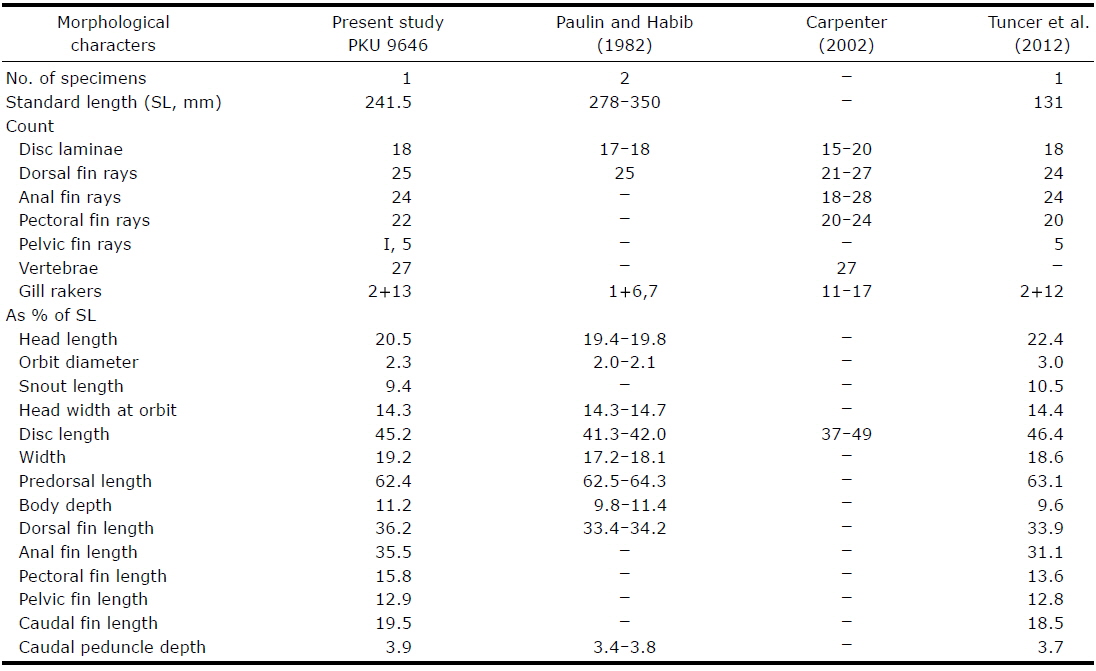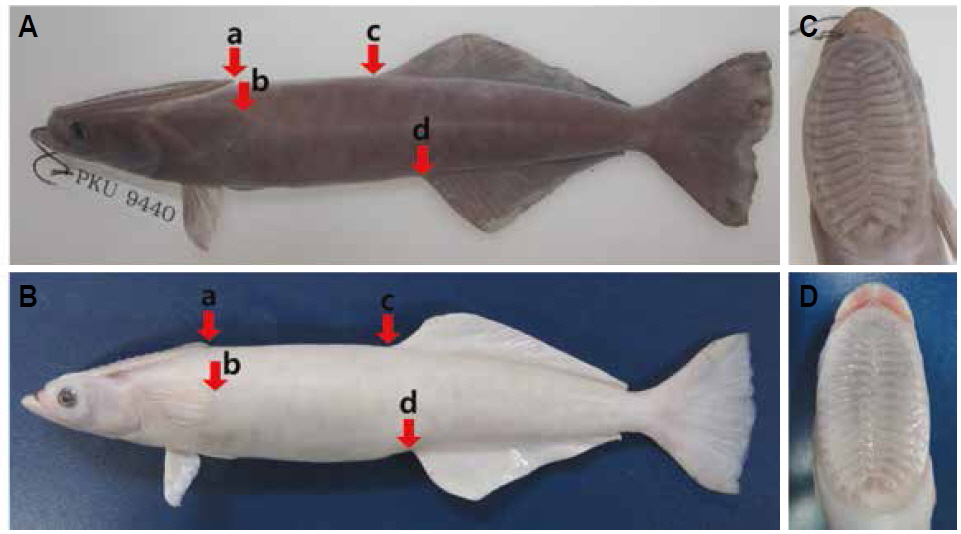



The Remora brachyptera and R. osteochir, belonging to the family Echeneidae were collected for the first time off Jeju Island, Korea, in July and August 2013 and off Ganggu-myeon, Yeongdeok-gun, Gyeongsangbuk-do in June 2014. Remora brachyptera is characterized by a sucker with 16 pairs of disc laminae and a dorsal fin that originates anterior of the origin of the anal fin. Remora osteochir is characterized by a sucker with 18 pairs of disc laminae and a sucking disc that extends beyond the posterior end of the pectoral fin. New Korean names proposed for the species are “Meo-ri-ppal-pan-i” for R. brachyptera and “Ppyeo-dae-ppal-pan-i” for R. osteochir.
The family Echeneidae, order Perciformes, comprises 8 species and 3 genera worldwide (Gray et al., 2009), 7 species and 3 genera in Japan (Hatooka and Kai, 2013), and 4 species and 3 genera in Korea (Lee and Joo, 2006). The Korean species are
The remoras have been the subject of numerous studies, including studies on the ontogeny and homology of the skeletal elements (Britz and Johnson, 2012), molecular phylogeny (Gray et al., 2009), morphological phylogeny (O’Toole, 2002), and geographic distribution (Dennis et al., 2004; Lee and Joo, 2006; Tuncer et al., 2012).
In the present study, two specimens of
Specimens of
Order Perciformes
Family Echeneidae
Genus
[Table 1.] Comparison of counts and measurements for Remora brachyptera

Comparison of counts and measurements for Remora brachyptera
Material examined. One specimen, 209.0 mm standard length (SL), collected by purse seine net off southern Jeju Island, Korea (33˚33′N, 128˚03′E), Jul 2013, PKU 9440; one specimen, 180.2 mm SL, collected by stationary net, Ganggu-myeon, Yeongdeok-gun, Gyeongsangbuk-do, Korea (36˚21′N, 129˚28′E), Jun 2014, PKU 11044.
Description. Disc laminae, 16; dorsal fin rays, 30; anal fin rays, 25-27; pectoral fin rays, 25; pelvic fin rays I, 5; vertebrae, 27; gill rakers 1 and 10 or 11 (Table 1).
Body stout and elongate (Fig. 1). Head flattened, with an oval and elongate sucking disc on the dorsal surface; sucking disc with 16 pairs of laminae; sucking disc does not extend to the posterior end of the pectoral fin. Scales of small and oval type, and irregularly arranged on body surface. Lower jaw rounded, protruding anteriorly; upper jaw pointed; both jaws with many rows of conical and curved teeth; posterior margin of upper jaw extending slightly beyond a line vertical to the anterior margin of the eye. Eyes small. Two pairs of nostrils; anterior nostrils smaller than posterior nostrils. Dorsal and anal fins without spines; origin of dorsal fin located more anterior than that of anal fin; posterior end of anal fin not reaching to posterior end of dorsal fin; pectoral fin rounded; origin of the pectoral fin anterior to origin of the pelvic fin. Lateral line starts at upper end of gill opening and reaches to base of caudal fin. Caudal peduncle stout; caudal fin slightly rounded (PKU 9440, PKU 11044).
Color. When fresh: body uniformly pale brown, except margins of fins are grayish to white. Head and body uniformly white (of PKU 11044) or brown (PKU 9440) (Fig. 1). In ethanol: color similar to that when fresh.
Distribution. Korea (present study); worldwide in warm waters (Lachner, 1986; O’Toole, 2002); New Zealand (Weber and de Beaufort, 1962; Paulin and Habib, 1982); Puerto Rico (Williams and Bunkley-Williams, 1996).
Remarks. The examined specimens belong to the genus
The two specimens showed large differences in body color. Their heads and bodies were uniformly purple in PKU 9440 but uniformly white in PKU 11044; similar variations in color have been mentioned by Hatooka and Kai (2013). We propose the new Korean name “Meo-ri-ppal-pan-i” for
[Table 2.] Comparison of counts and measurements for Remora osteochir

Comparison of counts and measurements for Remora osteochir
Material examined. PKU 9646, one specimen, 241.5 mm SL, collected by purse sein off southern Jeju Island, Korea (33˚39′N, 127˚13′E) in Aug 2013.
Description. Disc laminae, 18; dorsal fin rays, 25; anal fin rays, 24; pectoral fin rays, 22; pelvic fin rays I, 5; vertebrae, 27; gill rakers 2 and 13 (Table 2).
Body stout and elongate. Scales small and irregularly arranged over entire body surface. Head flattened and short. Sucking disc oval and elongate on dorsal surface. Eye moderately small. Lower jaw rounded, projecting past upper jaw; both jaws with many rows of conical and curved teeth; upper jaw does not extend to anterior margin of eye. Two pairs of nostrils; anterior nostril with a well-developed membranous rim; posterior nostril smaller than anterior nostril. Posterior end of sucking disc posterior to the posterior end of the pectoral fin. Pectoral fin obtuse; posterior end of pelvic fin extending beyond the posterior end of pectoral fin; shape of dorsal fin similar to anal fin; both dorsal and anal fins begin behind middle of body; dorsal and anal fins long and without spines; origin of dorsal fin located slightly anterior to that of anal fin; posterior end of anal fin not reaching to posterior end of dorsal fin; soft portions of dorsal and anal fins angular; pectoral fin rounded; origin of pectoral fin anterior to origin of pelvic fin; caudal peduncle slender; caudal fin truncated.
Color. When fresh: upper part of body blackish and lower part of body dark greyish; dorsal, anal, and caudal fins blackish; pectoral and pelvic fins dark greyish; iris dark brownish (Fig. 2). In ethanol: coloration shows no change after fixation.
Distribution. Korea (present study), worldwide in most tropical and subtropical pelagic environments (Lachner, 1986; O’Toole, 2002); Papua New Guinea and North Atlantic (Maul 1956; Paulin and Habib, 1982); Mediterranean (Tortonese, 1973); southeastern Aegean Sea (Kaspiris and Ondrias, 1984); Turkish waters, Aegean Sea (Tuncer et al., 2012); Japan (Hatooka and Kai, 2013).
Remarks. The examined specimen was identified as



